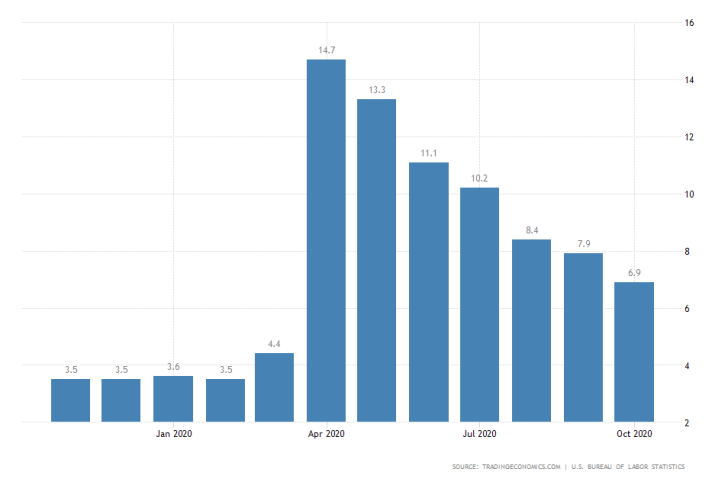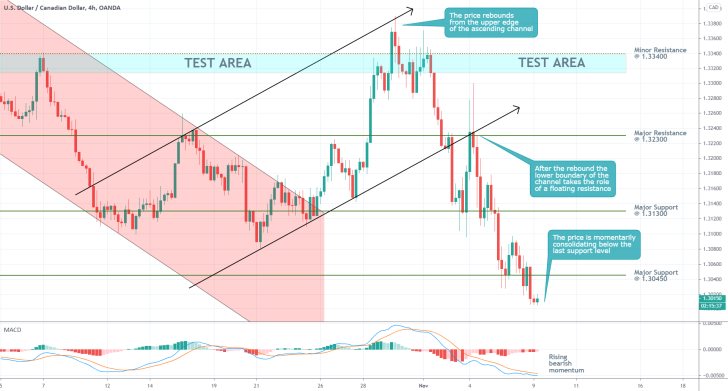
Last Friday, the Bureau of Labour Statistics in the US published the October Non-Farm Payrolls report, in which it was revealed that headline unemployment had decreased even more than initially expected.
According to the findings of the report, overall unemployment had sunk to 6.9 per cent over the previous month from September's 7.9 per cent. This is a considerably bigger depreciation compared to the projections for a smaller slide to 7.7 per cent.

As can be seen from the graph above, Friday's improvement marks the sixth consecutive reduction of headline unemployment since the massive upsurge in April owing to the outbreak of the coronavirus pandemic.
The American labour market is exhibiting resilience despite the uptick in COVID-19 cases in the States and elsewhere, which underpins the effectiveness of FED's accommodative monetary policy.
Nevertheless, the ongoing strengthening of the labour market could be jeopardised by likely disruptions in the underlying dynamics between monetary policy and fiscal policy.
President Donald Trump had previously used stimulus relief as a bargaining chip in the presidential race but since he lost the elections, it remains to be seen whether his administration would live up to the promise and pass the highly anticipated stimulus package bill. It is crucially important for FP and MP to work in concert with each other so that the robustness of the recovery process can be preserved.
The uncertainty stemming from the temporarily adjourned issue of FP is a cause of concern in Washington, as Donald Trump might yet decide to use it to stymie growth and leverage his position against President-elect Joe Biden.
That is why the outcome of the elections did not immediately resolve all outstanding questions, and the value of the dollar continues to be strained by persisting uncertainties.
As can be seen on the 4H chart below, the USDCAD pair quite expectedly rebounded from the Test Area (in blue) and is currently consolidating below the last remaining support level at 1.30450.
The struggles for the greenback are exacerbated by the prevailing bearish momentum, as demonstrated by the MACD indicator. It remains to be seen whether the recent breakdown below the above-mentioned support is going to be followed by continued depreciation of the price action, or by an immediate pullback above the support.

Trendsharks Premium
Gold is undergoing a correction, as investors take profits to offset losses from falling stock prices, impacting their margins. However, we anticipate a renewed wave of [...]
The Swiss stock market index is mirroring its global counterparts, such as Germany 40 and US100, experiencing a sharp decline following the announcement of new [...]
We’re analyzing the weekly chart to grasp the broader market trend. Over the past three years, the US30 index has surged by 17,000 points, often resembling a nearly straight [...]
Over the past week, the DAX has experienced a sharp decline, plunging by an astonishing 3,400 points. This downward movement is not isolated, as its international counterparts, such as the UK100 and US100, are also facing significant [...]
EURUSD recently formed a double top at 1.0930, signaling a potential trend reversal, and has since begun a correction. After a 600-pip rally since early March, a pullback at this stage is both expected and healthy. Given these conditions, we are placing a [...]
Since early March, EURJPY has surged nearly 1,000 pips, providing us with several excellent trading opportunities. However, as the rally matures, many early buyers are beginning to take profits, leading to a noticeable slowdown in the uptrend. On Friday, the pair formed a [...]
The AUDJPY currency pair continues to be dominated by bullish momentum, as multiple golden cross patterns reaffirm the strength of the ongoing uptrend. Despite this, we are witnessing a much-needed [...]
The EURAUD currency pair appears to be undergoing a trend reversal, signaling a potential shift in market direction. A notable technical development is the formation of a Death Cross on the chart, a widely recognized bearish indicator that typically suggests a [...]
After securing an impressive 200-pip profit last week, the EURJPY currency pair is now undergoing a southward correction, retracing some of its recent gains. Despite this temporary pullback, the Golden Cross remains intact, reinforcing our view that the overall trend continues to be [...]
The appearance of a Golden Cross in Silver strengthens our analysis that the metal is currently in a strong uptrend, indicating further bullish momentum in the market. This technical pattern, where the short-term moving average crosses above the [...]
This trade presents a considerable level of risk and can be classified as an opportunistic move based on recent price action. The GBPUSD currency pair has experienced a substantial bullish rally, surging by nearly 500 pips in a strong upward movement. However, after this extended period of appreciation, the pair is showing signs of a potential [...]
The anticipated Death Cross on the SMI20 appears to be failing as price finds strong support at the 23% Fibonacci retracement level. After testing this area, the index has shown bullish strength, printing several large green candles, signaling an increase in [...]
A Golden Cross has just appeared on the USDJPY chart, signaling a potential bullish move. This technical pattern occurs when the 20 period moving average crosses above the 60 period moving average, a widely recognized indication of increasing [...]
After 2 months of a down trend, we finally see some indications of price recovery for Oil. The golden cross, a historic buy signal, supports this [...]
For the past month, the German DAX40 has experienced a remarkable 10% surge, reflecting strong bullish momentum. Despite ongoing market volatility and frequent pullbacks, every dip continues to attract fresh buyers, reinforcing the [...]
Oil continues its downward trajectory, despite occasional pullbacks. The overall trend remains bearish, reinforced by multiple Death Cross patterns, a classic sell signal indicating further weakness. Adding to this bearish outlook, the critical [...]
Over the past few days, gold has experienced a sharp decline of more than $100. This downturn can be attributed in part to traders securing profits to manage their margins, which are under strain due to the significant drop in major indices. Currently, gold has fallen below the [...]
The NASDAQ 100 index is showing strong bullish momentum, as evidenced by the formation of a Golden Cross on the chart. This classic buy signal occurs when the short moving average crosses above the long term moving average, suggesting that upward momentum is [...]
The EURAUD currency pair has encountered a significant resistance level, failing to break above the critical 61% Fibonacci retracement level. This suggests that bullish momentum is weakening, reinforcing the case for a potential downward move. Given this technical setup, we favor entering a [...]
The UK100 is experiencing a remarkable rally! Over the past few weeks, the British stock market index has surged nearly 800 points. Each minor dip has attracted more buyers, fueling the bullish momentum. However, since last week, we’ve observed a slight [...]




















